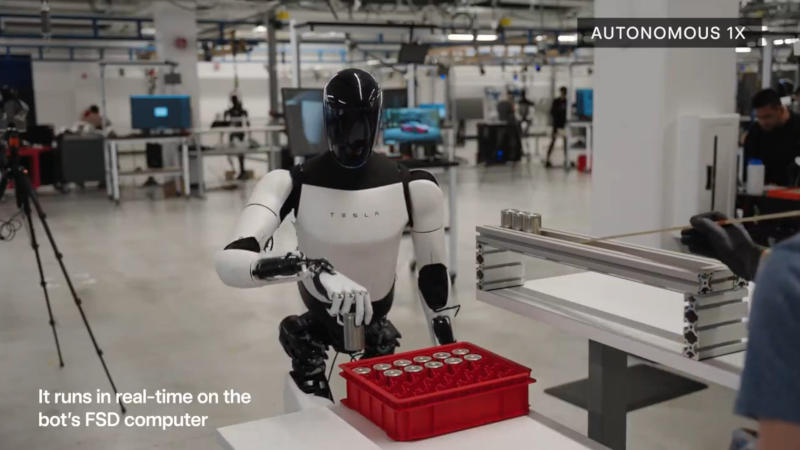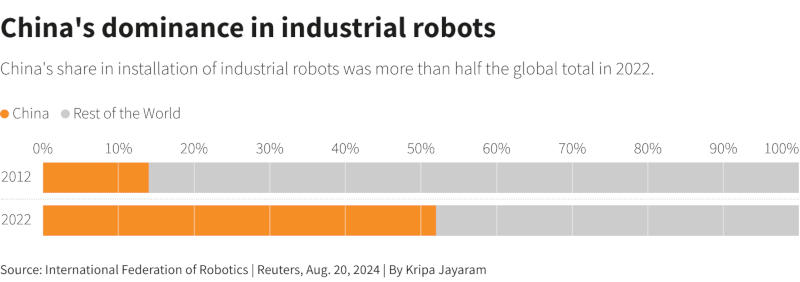China has become the world leader in electric vehicle production. Now he intends to catch up with Tesla in the field of humanoid robots with autonomous power supply, which can replace humans in the assembly of electric vehicles and more, writes Reuters.

Image source: x.com/Tesla_Optimus
At the World Robot Conference this week in Beijing, more than two dozen Chinese companies demonstrated humanoid robots – machines designed to work in factories and warehouses. And they further demonstrated the components necessary for the production of robots. China’s progress in the emerging industry is based on a formula that has proven successful in the electric vehicle industry: government support, cutthroat price competition among a large number of new entrants, and a streamlined supply chain.
Beijing launched a $1.4 billion government robotics fund in January; In July, Shanghai announced plans to create a humanoid robot industry fund with the same $1.4 billion budget. Some of the robots unveiled this week were built with the same suppliers that have powered the growth of the electric vehicle industry, including manufacturers of batteries and various sensors. By 2035, the global market for humanoid robots will reach $38 billion, with 1.4 million units shipped to consumers and industry, according to a Goldman Sachs forecast presented in January.

In 2022, China accounted for more than half of all industrial robots installed worldwide. Image source: reuters.com
«There is a lot of scope for cutting costs. China specializes in rapid development and production,” said Hu Debo, head of Shanghai Kepler Exploration Robotics. He founded his company last year, inspired by the humanoid Tesla Optimus. Now his company is already working on the fifth version of the working robot, which will be tested in production. One such robot is expected to cost less than $30,000. By opening a plant in Shanghai in 2019, Tesla created what is called in China the “catfish effect”: a large competitor forced local companies to speed up their work. Tesla Optimus had a similar effect, Mr. Hu is sure; and Elon Musk himself said in 2021 that over time, humanoid robots will turn out to be a more significant direction than electric cars.
Tesla Optimus uses an artificial intelligence system similar to the Full Self-Driving platform that powers electric vehicles. Chinese analysts and industry representatives acknowledge that Tesla has an advantage in AI, but China still has room to reduce production costs. At an exhibition taking place alongside a conference in Beijing, a mannequin-like Optimus stood in a plexiglass box next to a Cybertruck electric pickup truck. And now the robot Mask has been surpassed by many Chinese humanoids – they walked, waved their limbs and even shrugged their shoulders, but Optimus still remained one of the most popular exhibits, and many wanted to take a photo with him. “Next year there will be more than 100 of my comrades at the plant,” read the sign next to him. Tesla has confirmed that it is already ready to move beyond prototypes and will begin production of Optimus in small volumes next year.

In 2022, China surpassed all countries in the number of installed industrial robots. Image source: reuters.com
The Chinese UBTECH Robotics also tests its robots at car factories. First, it collaborated with Geely, and the day before it announced an agreement with the Audi plant in China. Next year the company intends to enter mass production – up to 1,000 units will be employed at the factories. UBTECH robots are based on Nvidia chips, but more than 90% of the components are made in China. Today, manufacturing robots are basically giant robotic arms that perform welding and other tasks. They were developed mainly by the Japanese Fanuc, the Swiss ABB and the German Kuka, which belongs to the Chinese manufacturer of household appliances Midea. China is the world leader in the number of production robots used in enterprises, more than three times ahead of North America in this indicator, according to statistics from the International Federation of Robotics.